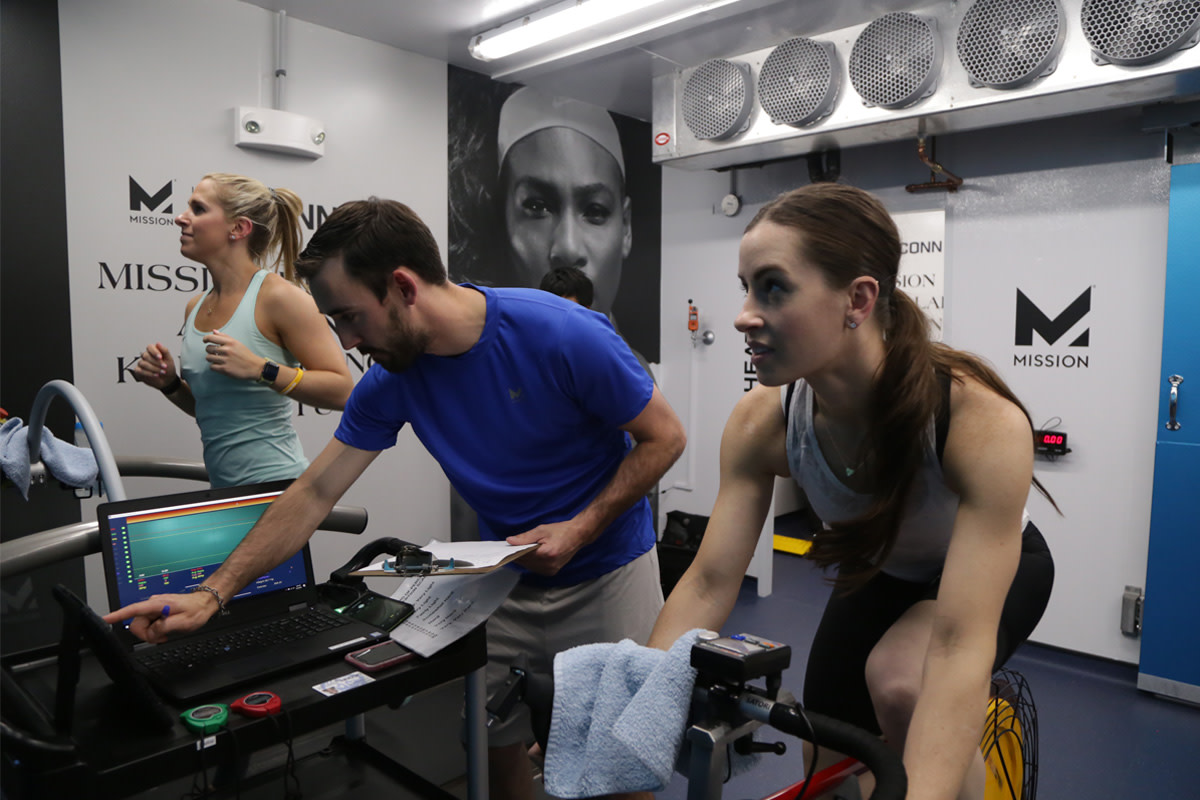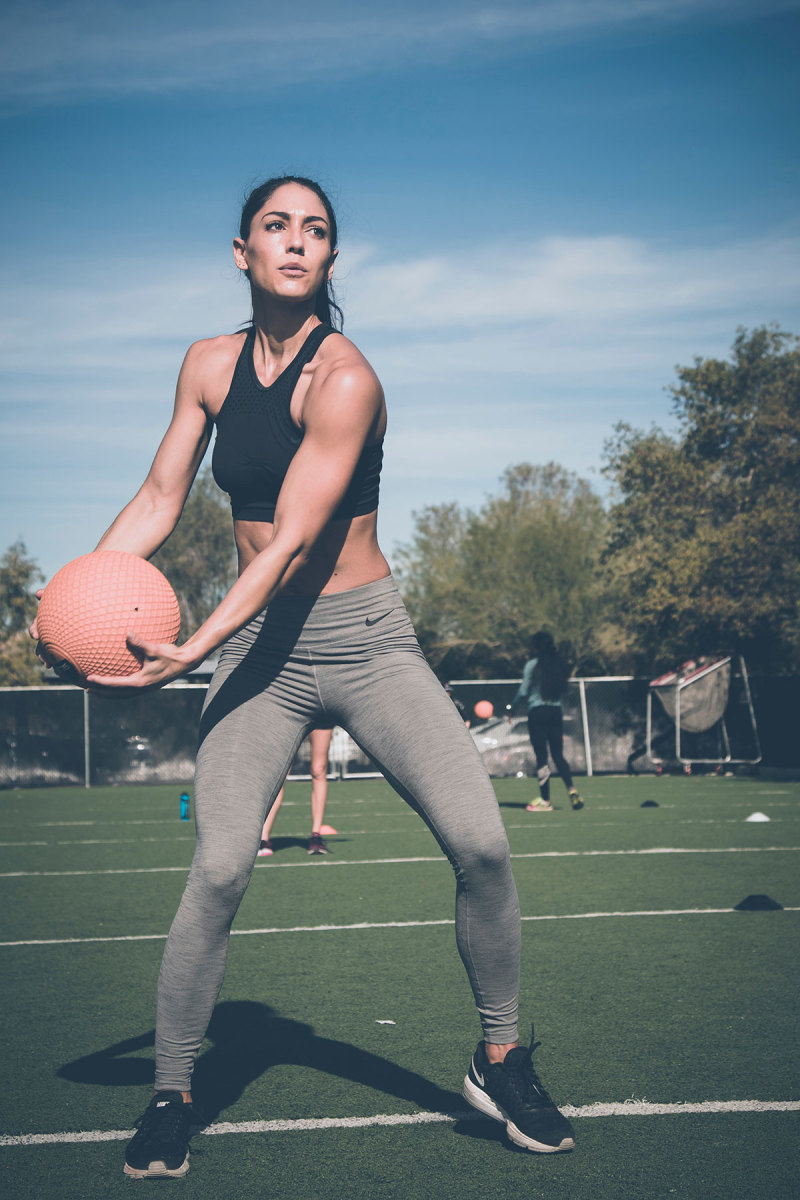It’s 90 degrees and humid outside. The last thing you want to do is workout in the heat—but did you know that training in the heat could actually work to your advantage?
I had the opportunity to visit the Mission Heat Lab at the University of Connecticut campus in Storrs, CT. In the lab is a heat chamber that can be set to up to 110 degrees, and the humidity set between 10 and 90 percent. Inside the chamber, you can hop on one of the bikes or treadmills which will track your heart rate, core temperature, body mass, wattage, pace/speed and sweat rate.
All of these factors are then used for sweat electrolyte and sodium balance tests, which can tell a person the amount of electrolytes he or she loses at a particular temperature, going a specific wattage, for a set amount of time.
“For athletes, they can set the temperature and humidity to match specific race conditions,” explains Robert Huggins, PhD, ATC, vice president of research and athletic performance and safety at the Korey Stringer Institute at the University of Connecticut. This would allow, for example, a triathlete to set Kona, Hawaii-like conditions so that they test in the same environment in which they’ll be racing.
“Using the electrolyte test, which involves sweat weight before and after, and a distilled water wash-down to remove electrolytes to back calculate the concentrations, we can give recommendations that the athlete would need for that race based on the amount [of weight and electrolytes] they lost during the test.” That number can then be taken and used to help map out proper hydration and fueling for a longer race if need be.

Since I’m obviously not a professional athlete, I was just curious to find out my sweat rate running in the heat for a half hour. By taking an ingestible core body temperature sensor pill, which wirelessly transmitted readings to a recorder device outside my body, measuring my weight before and after the test, and exactly how much water I drank during the heated run, I was able to learn that I lose .74 liters per hour. That means that at that same temperature, if I were to run an hour, the perfect amount of fluid I should be taking in would be .74 liters because that’s how much I was sweating out.
Running in the heat for that long didn’t seem all too daunting at first, but by the end, I was so sweaty that I was counting down the minutes for it to be over. But I learned that when done safely, working out in the heat is actually very beneficial.
“With as little as five to seven days of training in the heat, and keeping your core temp between 101.5 to 103.0 with proper hydration for 60 minutes, you can achieve lots of benefits,” explained Huggins. Achieving this stabilization of core temperature and proper hydration is often called heat acclimatization.
“From a physiological standpoint [with heat acclimatization], your heart rate is lower at a given intensity, and blood volume expands allowing you to deliver more blood to the exercising muscles and to the skin for cooling via sweat,” Huggins said. “Most importantly, your core temperature is lower both at rest and during exercise and your body becomes a more efficient sweater.”
And, he explained, if you can push heat training up to 10 to 14 days consecutively, you can also hold onto electrolytes and fluids better. Overall, you can become a more efficient athlete by sweating more efficiently, adjusting to the heat and maximizing your use of electrolytes.
For most athletes or people who exercise three to five times per week, it can take about two to three sessions of training in the heat for someone to feel more comfortable moving the body in hot conditions. But each person is different—some may take a full week depending on their fitness level.

“In general, the more aerobically fit you are, the quicker you get used to it,” explains Huggins. “Once you achieve heat acclimatization, or ‘Heat Acc’ for short, in order to hold onto the benefits of the adaptations your body has made, you need to continue to exercise once every five days in the heat.” However, even after achieving Heat Acc, “if you go 10 to 14 days without exercising in the heat, a majority of those adaptations will be lost,” Huggins adds.
Of course, it’s easy to track your core temperature in a lab like the one I was in. For everyday athletes who don’t have access to a lab, the only way to accurately track your core temp—to be sure it’s in the correct range without spiking to an unsafe level—is to take your temperature rectally. That would mean pausing your run, bike or workout to get your temperature—not exactly ideal, or likely to happen.
The good news is you can track your sweat rate to find out how much fluid you’re losing when you exercise for a certain amount of time in a particular environment. Simply step onto a scale with a full water bottle before your workout, then work out and drink the water, and when you finish, step back onto the scale. The difference in your weight is your sweat rate or how much fluid you lost.
For athletes looking to improve performance, or for those who are just trying to stay hydrated on that next summer trail run, this could be a game-changer. “If you’re having fueling issues, whether it’s over or under hydrating, this is a great way to hone in on that and figure out exactly how much fluids your body needs in specific conditions for a specified amount of time,” Huggins concludes.
from Men's Journal https://ift.tt/30cE4bw
via IFTTT








0 comments:
Post a Comment